

Catch Fish with
Mike Ladle
Information Page
Freshwater Fishing
For anyone unfamiliar with the site always check the FRESHWATER, SALTWATER and TACK-TICS pages. The Saltwater page now extends back as a record of over several years of (mostly) sea fishing and may be a useful guide as to when to fish. The Freshwater stuff is also up to date now. I keep adding to both. These pages are effectively my diary and the latest will usually be about fishing in the previous day or two. As you see I also add the odd piece from my friends and correspondents if I've not been doing much. The Tactics pages which are chiefly 'how I do it' plus a bit of science are also updated regularly and (I think) worth a read (the earlier ones are mostly tackle and 'how to do it' stuff).
'Small' circle hooks for freshwater predators.
Following my recent catches of perch and pike on paternostered livebaits (mostly minnows) I realised that I have not done any free-lining with these baits recently. It is clear that fishing with small, live fish is often a superior tactic for catching predatory fish species in my local rivers and elsewhere. Most of my catches on natural baits have been coarse fish with the occasional trout or seatrout. I have to admit that although the trout are equally keen on small fish baits they have proved less easy to catch using these tactics than the coarse fish species (they often seem to drop or spit out the baits without being hooked).
As I've said on a number of occasions my livebaiting set-up is never ideal because, due to the ever-present pike, I HAVE TO use a short wire trace even when I'm after chub, perch or trout. The wire is pretty flexible and can, with a little care, be knotted but I would use nylon if that were possible. My preference is for unweighted tackle with only a baited hook. However, when fishing in deeper or fast flowing water I sometimes use a light paternoster with the wire trace as a dropper. (see Freshwater page 496).
To give a sense of how I go about this type of fishing , I'll delve back one or two past sessions. The circle hook, usually size 8 or 6 is knotted to the end of the wire and the small swivel at the other end of the trace is then tied to the nylon-mono (about 1m long) linking it to my braided line. This nylon is effective in preventing snarl ups between the stiffish wire and the soft braid. Having trapped or fished for my minnow baits, I carry them in a small amount of water in a handy bucket. For fishing, the minnow is lightly hooked through the top lip. I walk the banks or wade slowly upstream through shallow water flicking the bait ahead of me, usually casting upstream and across, into chubby, perchy or trouty looking places. Here's a description of events from one of my trips a year or two ago; forgive the repetition -
"I cast out and as the minnow settled I felt the line twitch. I waited until I could feel the weight of whatever had taken the bait and then gently tightened (striking is a no no with these hooks) and I was in. Sure enough it was a chub, no monster but a nice fish of about two-and-a-half-pounds. The circle hook was firmly in the upper lip so, having taken a couple of pictures as I reeled in, I unhooked and released the fish which instantly swam off. Good start!"
A chub, nicely hooked on my little circle hook.
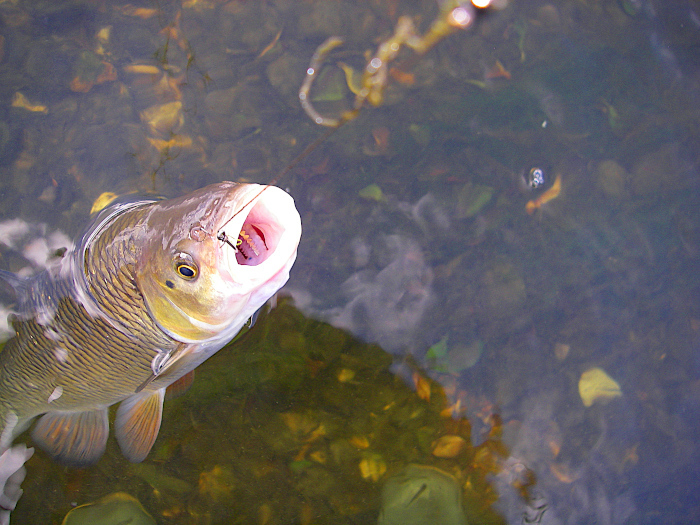
Closer view of the hook-hold.

Not a bad fish.
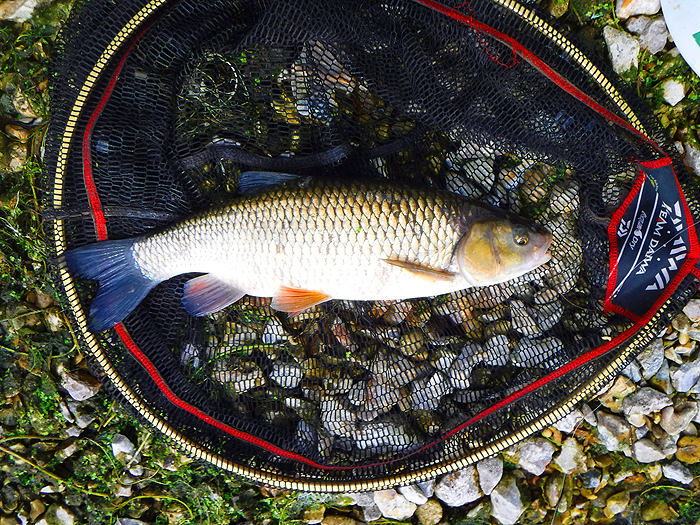
"I rebaited and plodded on upstream. I came to a large slack and I flicked the minnow up towards a patch of lilies. Again the bite came before the minnow had sunk to the bottom (this is fairly typical, most of these fish can't resist minnows). After the line drew tight, the bump, bump battle signalled that this time I was into a perch; again I took a picture before returning it. In the next half-hour or so I had four more perch. Like the first one they were all neatly hooked in the scissors but I also dropped several, which were presumably less firmly attached." Eventually I cast into a snag and lost the hook. At this point I switched to a J hook, to see whether it would be more effective at hooking the perch. I baited up again and flicked out the minnow. As usual there was a bite within a few seconds and this time I struck quickly. It was not a big perch - probably my smallest of the session - but when I reeled in I was dismayed to find that it was hooked in the back of the throat. It was quite a palaver to remove the hook and this persuaded me to stick to using circle hooks in the future.
Of course, on and off, I'd caught chub using circle hooks for years. On the unweighted tackle, it is generally easy to feel the plucks of a taking fish and then it's simply a matter of gently tightening the line until the fish is hooked. Using circle hooks the chub (or perch, trout or pike) are almost always lip hooked, so it is easy to release them undamaged. As a rule I get many more bites per session on natural baits than when I'm spinning an artificial; this is probably because the bait is real and it is slightly easier to present my offering to the fish without scaring them. I expect that, for chub, a slug or lobworm might work just as well as a minnow, but on most occasions, minnows are more easily available to me.
A lovely perch on live minnow.
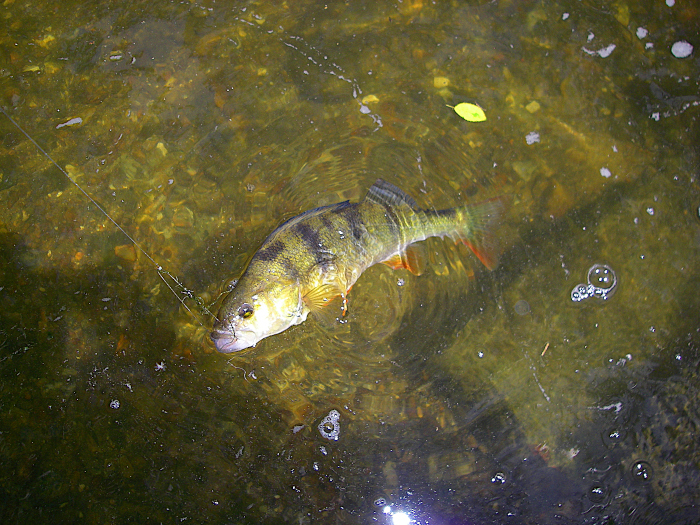
Typical circle hook placement.

A much better perch on a livebait.

As mentioned above there are snags to this type of fishing. Jack pike can be a problem as their razor sharp teeth easily slice through mono line, so in my local rivers it is always necessary to use a wire trace. Knottable wire such as 'AFW Micro Supreme' which is relatively easy to tie, fairly flexible and apparently not too visible to the fish seems OK, and up to now I've no evidence that it puts ANY fish off. As baits, I always prefer the biggest minnows I can get, partly because they are easier to cast a fair way. Often, my main problem is catching bait and on the odd occasion the minnows seem to be few and far between. This can be frustrating.
To avoid carting a second (bait catching) rod about with me I sometimes tie a few inches of fine nylon to the circle hook, knot on a size sixteen, add a maggot and dabble it where I can see suitable baits. Given and inch or two of fresh water in my bucket the little fish stay in good condition and spare ones can be released when I pack in. After casting upstream, by reeling in to keep pace with the flow of the river it is possible to stay more or less in contact with the bait. A bite will be signalled when you see or feel the line twitch and then, as I've said, it is simply a matter of slowly tightening the line and reeling in.
Now another trip - "My pal Ben wanted to do a spot of piking (he'd been confined to barracks for a while with his new baby) but I again decided to persist with fish-baits to try for a perch. Our tactics were similar in that this time we both used small fish as baits. Ben's baits were much larger than mine and he used a float so that they would 'search' the water. My titchy offerings were tethered to a half-ounce weight on a paternoster rig, so I could drop them exactly where I thought there might be perch. Ben's circle hook was about a 4/0 and mine the usual size 6, both were on fine wire traces."
"It wasn't long before my pal had his first pike. Then he had another, and another. Of the perch there was no sign. To be honest I wasn't too surprised as they are sometimes a bit thin on the ground in that stretch of river. We came to a ditch joining the river. An old bridge of scaffold poles had fallen into the mouth of the ditch and I thought it a possible perch spot. Within seconds of dunking my bait it was grabbed by a pike and - DISASTER! - the pike shot under the sunken poles and out into the river. I could feel the line grating round the rusty scaffolding as the fish dragged off line against the clutch. All went well until the fish was almost back in the ditch then, inevitably, the line parted just above the wire trace. I said a few choice words (mostly regarding my stupidity for fishing in that spot). A few minutes later, out in the River, Ben shouted 'fish!' and began to play another pike. He landed it and as he removed the hook, there, in the pikes jaw, was my little circle hook. All's well that ends well."
A few days later I decided to try my 'perch' tactics in another local river where there are more perch. Again, I used a wire trace. " I tried one likely pool after another - nothing! Then I saw a green flash and the sweep of a big tail as a pike hooked itself. I played it out and landed it after negotiating a barbed wire fence and a metre-high bank. The pike was nicely hooked round the maxilla on my small hook - excellent. By now I was almost back to where I had started. I dropped the little bait into the umpteenth hole and within seconds it was grabbed (in full view) by a decent perch. I tightened and the fish was hooked. I landed the fish, took a picture and dropped in another bait. This time another perch, about the same size as the first, swam up to my bait with evil intent, then suddenly, it turned tail and rocketed away into the gloomy depths - What was that about??? I did not have long to wait before I found out, as a green torpedo lunged up from the deeper water and took my bait. I landed and returned the pike, again nicely hooked on the size 6 hook. Two pike and a perch plus a 'nearly perch' - better!" It occured to me that the small circle hooks may be more than adequate for piking too (provided the bait isn't too large to leave the hook exposed).
A decent pike on a small circle hook.
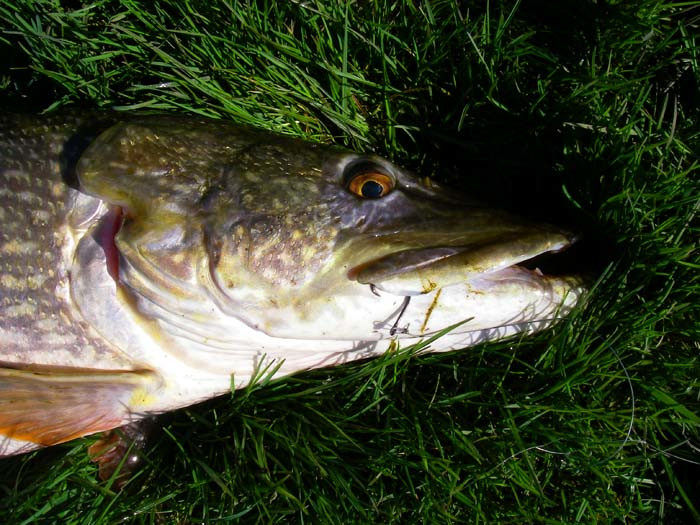
Another small hook and the paternoster set up is visible.
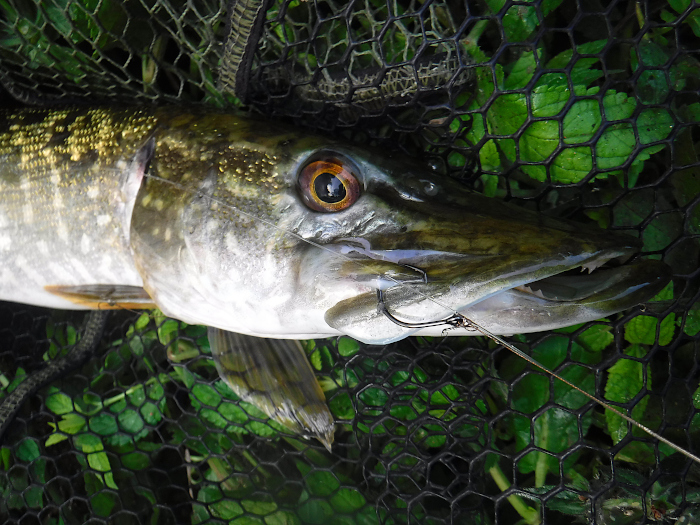
Ben's pike with my small hook still in the jaw and Ben's larger hook also visible.
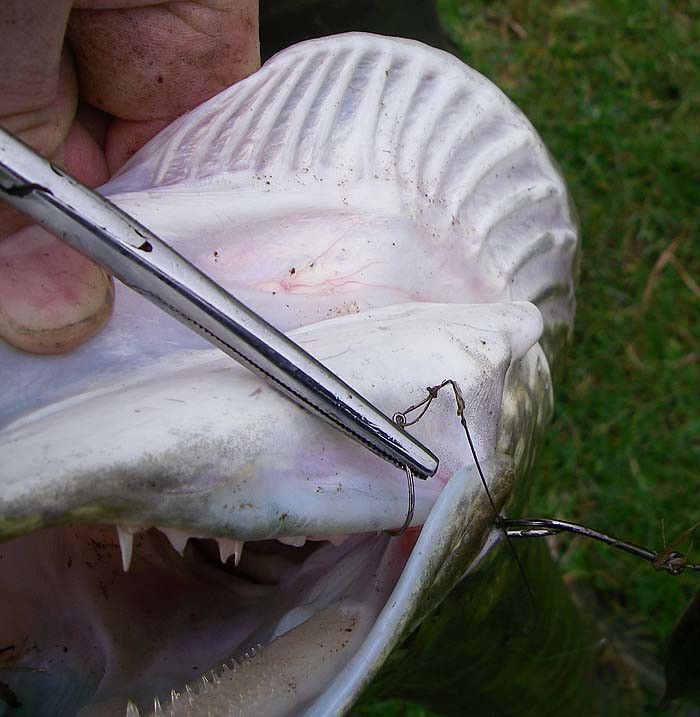
If you have any comments or questions about fish, methods, tactics or 'what have you!' get in touch with me by sending an E-MAIL to - docladle@hotmail.com